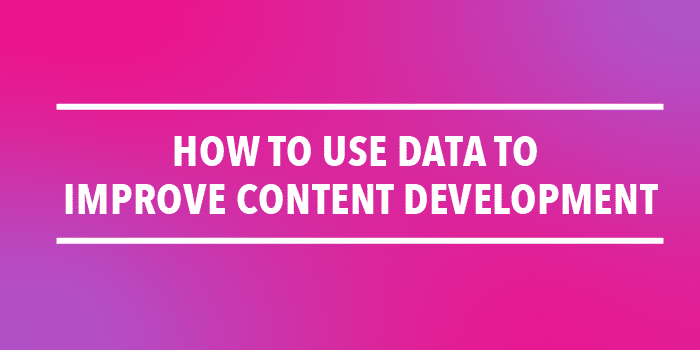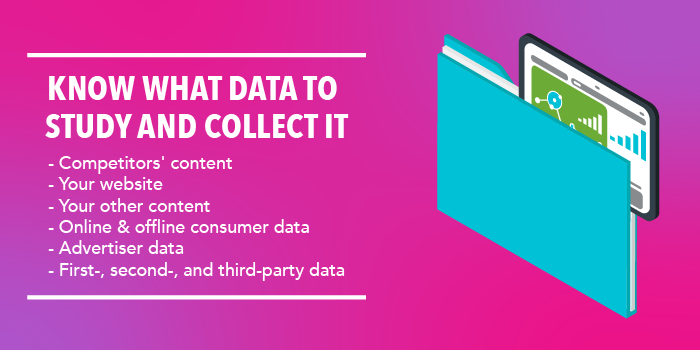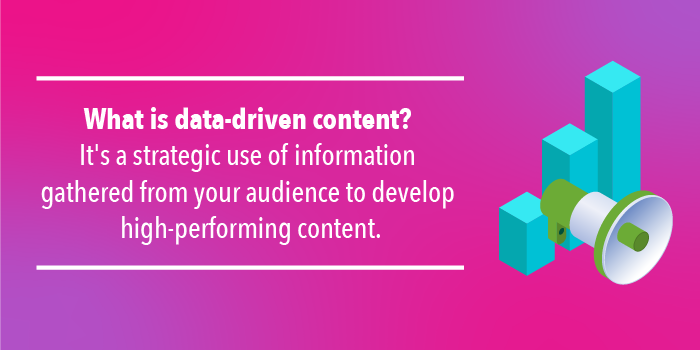
As a publisher or content marketer, your team has a wealth of data resources at your fingertips. Your website and social media analytics tell stories about who your readers are and what content sticks with them. Other tools offer insights about your competitors’ content and the audience you haven’t reached yet. You can capitalize on so many sources of data to create valuable, shareable content.
Why Data Should Influence Your Content
Among B2C content marketers, 78% are using metrics to measure content performance. That number jumps to 93% in organizations with a sophisticated content marketing strategy. Marketers who aren’t already using data to create content are missing out on critical information. Besides measuring outcomes, data can also give you robust insights to hone your content strategy.
- Evaluate ROI on content: There are three critical measurements of successful content — traffic, engagement and conversions. Traffic is the raw number of people who visit your site. Engagement can be measured in the percentage of clicks on content, clicks to another page on your site, or how long they spend on a page. Conversion rate indicates how many people take action after engaging with content. Often, a user converts by subscribing to a newsletter or making a purchase online. Each of these measurements can be used to calculate the return on investment (ROI) of your content and help drive you towards higher ROIs.
- Understanding your target audience: While raw traffic is valuable, what’s even more crucial is qualified traffic. The people you want browsing your site are the ones likely to buy your product, read more content or use your service. Data can tell you more about your audience to see what percentage is actually your target. It can also tell you what your ideal readers are doing online to help you draw them to your site and create the personalized content they want.
- Targeting the right channels: Your audience members behave differently depending on where they interact with your content. Someone who finds your content through social media might react favorably to a more visual, interactive experience. Someone who asks a question on Google might scan your blog to see if you answer their question. Further, different people prefer different types of content. Understanding how to shape your content for various platforms and who to target through different channels can make your content more successful.
6 Tips for Using Data to Drive Your Content

Only 18% of marketers, PR professionals and business owners rate themselves highly in data literacy. The truth is, content and data should go hand-in-hand. Most marketers’ and publishers’ analytics platforms are flooded with data they can harness to make smart decisions and improve content development. With the right tools and skills, capturing and enhancing your audience data can transform your content strategy and draw in new subscribers. Follow these six tips to start taking advantage of data-driven content marketing.
1. Know What Data to Collect and Study
Your content and the internet at large are filled with valuable data points when you know what to look for. Data can be difficult to parse through without a clear idea of what content goals you’re hoping to achieve. There are many sources for data. Some will be easy to find using your analytics trackers. Others may require some digging.
- Competitors’ content: You can use several methods to benchmark your competitors’ content and see what is most successful. A combination of paid and free tools allow you to see how much traffic pages on other sites are getting. You can learn what keywords their content ranks for on search engines. You can also view how many likes and shares their content receives on social media platforms.
- Your website: Your website analytics provide a host of data. First, traffic tells you how many visitors a page has. You can also see the length of the average session, which can tell you how long people spend on your site. You can combine this information with pages per visit to see which content drives readers to consume more. You can look at content overall and see what topics are driving the most visitors and determine if you can create more of those pieces. Your website’s analytics can even tell you how readers end up at your site and where and how often your content is being shared around the web.
- Your other content: Your social media posts, as well as your guest posts around the web, are more critical sources for data. Your link clicks on social media platforms tell you how many people click on the articles you share. It can be a fantastic measure of successful headlines and the relevance of the topic to your followers.
- Online and offline consumer data: You can get a complete picture of your customers by combining online and offline data. If a customer spends an hour on your site clicking through content before driving to the store to buy your product, your website analytics won’t pick up on this. Your ecommerce customers might be reading and consuming different content than your brick-and-mortar customers. Tracking these points of diversion can help you focus your content strategy. Integrating your online and offline customer data is central to painting a complete picture of your target audience’s behavior.
- Advertiser data: As a publisher, tracking your advertisers’ data is central to helping you fulfill your RFPs for targeted ads. You need to understand your audience to target ads on each client’s behalf. You also need to track the data from advertisers to increase your ad sales. As a media owner, you can also use a data collaboration tool to discover key insights from advertiser data that can help make your own inventory more valuable.
- First-, second- and third-party data: You can collect a lot of your own data. Your website analytics and your offline consumer data are first-party data, which may be limited in scope. Your best customers only reveal so much when they interact within the universe of your site or app. What other interests, behaviors, and passions do they have? You can expand on your first-party data to draw more informed conclusions and understand the changing consumer by combining it with second- and third-party data, which you can purchase from other sources.
2. Consider Your Target Audience
Segmenting audiences and capturing better data from site visitors is a top priority for 30% of marketers. It is crucial to help you better shape your content for the people you need to reach.
Patterns of behavior, such as the time spent on social media or online shopping, can help you target content towards users who behave similarly. You can also use spending habits to focus your targeting strategy.
Collecting and managing data can give you a clearer understanding of who your audience is and how they behave.
- Learn about your target audience: Your website analytics provide rich demographic data. Some things you can learn include gender, age, location, income, career, spending habits, pain points and emotional triggers. Your first-party data can offer some insights into your target audience, which can be further enhanced with second-party data collaboration and third-party data enrichment.
- Understand your current audience: Not everyone in your existing audience is part of your target audience. Using your first-party data, you can learn more about who your audience is. Are there new demographics you should target? What percentage of your site visitors are potential customers or suitable matches for advertisers? If you are a publisher, knowing your audience can help you increase ad sales.
- Enrich your view of your audience: While your first-party data is reliable, it’s often limited. You can learn more about your audience and the viewers you want to attract with second- and third-party data. By combining many data sources, you can get a complete view of your audience. Data management and enrichment tools such as Lotame Panorama Identity give you a full panorama of your audience.
3. Find Out What’s Not Being Talked About
Data from around the web can drive your content strategy. You can find popular topics by searching for a broad term and seeing what articles come up. Some free and paid tools take this a step further, showing you how content ranks in search engines and how many shares it receives across platforms. Of course, piggybacking on popular content can help you get into the conversation and may lead to new subscriptions. Data on trending topics can be valuable in generating these content ideas.

What’s more useful is capitalizing on relevant topics that aren’t yet on your competitor’s radar. If you can be the first to bring up a unique idea, you can bring new attention to your website, increasing your traffic. It can also help you establish yourself as a subject matter expert.
The key to finding content that’s not being talked about is keyword research. Look for keywords that are searched for often and don’t turn up many high-quality results. By looking for high-volume keywords, you get a window into what readers are trying to learn more about. By finding the often-searched keywords that have fewer competitors, you can add value to the conversation. Using focused topics and original angles, you can be the first to bring ideas to the discussion.
4. Analyze Reading Behavior Across All Channels
Knowing how readers interact with your content online can bring clarity to your content strategy. Having a complete view of this data lets you know what types of content to focus on. Your website data may tell you that your audience is spending a lot of time clicking through videos and not reading your written content. You can then adjust your strategy to create more video content for viewers. You’ll also know to take a deeper dive into your written material to understand what isn’t engaging.
Analyzing reader behavior can allow you to segment readers by preferred content type. You may find that certain products are appealing most to your video-watchers, or that blog readers are more likely to buy in-store than online. You can also see how long visitors stay on your site, and which pages they click through. Using this information, you know what pages encourage readers to click around. You can then hone your content to work for different points in your sales funnel.
It’s also vital to understand how your content performs on different platforms. It’s no secret people are primed for different user experiences on various platforms. An engaging LinkedIn post might not get the same traction on Twitter, for example. Each platform has a unique algorithm for promoting content, which can also affect how content performs on different platforms. All this information can help you tweak how you post content to different social media sites.
5. Blog and Post Content Frequently
Data suggests that the more often you post content, the more your traffic grows. It makes sense — writing more articles on the same subject helps you build authority. While one or two blog posts per month can generate an average of 100 new visits, 16 new posts per month increase that traffic to 350 new visitors. While this much content is not feasible for all content teams, generally, the more you can put out, the better.
You can also use data to learn how frequently to post on different platforms. While many people think posting more often on social media will lead to more clicks, it’s not always the case. Posting too frequently makes some followers more likely to ignore the content. Some algorithms even reward higher organic reach to accounts that post higher quality content less often. The best avenue is to look at your social media analytics to see how posting frequency affects your reach and engagement.
Besides posting more often, try posting longer content. In 2020, the average first-page result on Google is 1,447 words long. Comprehensive, in-depth content has been shown to perform better on Google and provide a top-notch user experience to readers. If you need help reaching a higher word count, you can use Google search data to help. Alongside many search results, Google sometimes provides a list of “People Also Ask” questions. Incorporating these other frequently-searched questions into your content gives you an excellent, data-backed way to cover a topic in more depth.
6. Engage Audiences With Data-Informed Content
So, what is data-driven content? For one thing, it’s a strategic use of information gathered from your audience to develop high-performing content. It’s also used to suggest content to audience members using algorithms and user data. To create high-impact content, use your analytics platforms to analyze what content on your site is resonating and where it’s being shared around the web. From there, decide what kind of content and which topics to prioritize moving forward.
Next, use a combination of first-, second- and third-party data to get a rich view of your audience. You can use Lotame’s data collaboration tools to enrich your first-party data with attribute and behavior data from over 250 online and offline data providers. Our Spherical platform synthesizes many data sources to get a complete view of your audience at the individual level. You can use this data to segment your audience and create content that appeals specifically to each group.

You can also use this data to personalize the content experience to each individual. Based on what content a visitor expresses interest in, whether it’s a specific topic or format, you can predict what other content the user will enjoy. With data connected to particular visitors, you can customize what your landing page looks like when they arrive on your site. You can also personalize the content in subscribers’ newsletters.
Lotame helps you deliver data-driven content. With our data tech, which integrates with your content management software (CMS) and content recommendation platforms, you can personalize suggestions with ease. You can use this to develop content that resonates and deliver super-relevant content, so your audience clearly sees the value you add to their day and keeps coming back for more.
Understand Your Audience With Lotame
Getting a complete view of your audience is simple with Lotame’s end-to-end data collaboration platform, Spherical. Enrich your first-party data and understand your customers’ changing behaviors down to the individual level. With more than 250+ high-quality data sources, Lotame can help you fill in the data gaps and answer critical questions about your customers digital lives. Bolster your competitive intelligence, deepen connections with customers, and personalize your content to what truly matters to your audience.
Learn more about Lotame’s powerful data enrichment and data collaboration tools are designed to inform and enhance your content strategy.